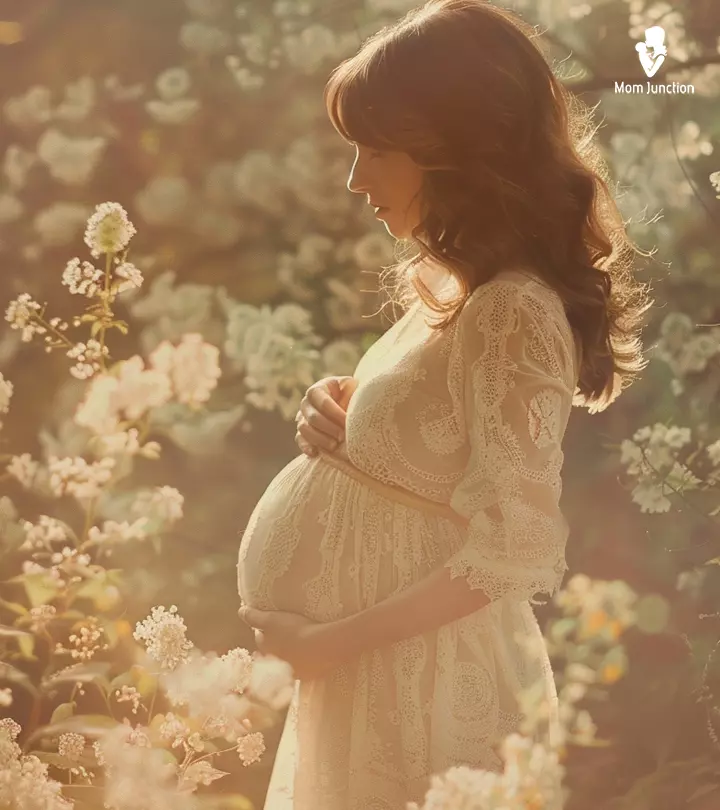
Image: Shutterstock
Even before they are born, your life begins to revolve around your baby. You appear to be preparing your home and life to accommodate your baby’s requirements. Therefore, it is good to be aware of some fascinating facts about babies.
You have celebrated your baby showers and taken maternity leave to prepare for the arrival of a new beginning in your life. When you first bring your baby home, everything about them both worries and delights you, such as their wailing, smiling, and laughing. In addition to being adorable and innocent, babies have a remarkable blend of talents and abilities.
Key Pointers
- Newborns have 300 bones and do not produce tears when crying.
- Babies are born without kneecaps and are frequently sleepy.
- Babies’ initial hair falls out and is replaced by new hair.
- Babies have more taste buds than adults and can recognize music heard in the womb.
- A baby’s body is not proportionate at birth, and their eye color may change.
28 Truly Amazing Fun Baby Facts
Physical development
Babies undergo rapid skeletal and muscular changes as their bodies adapt to life outside the womb, including bone fusion, significant weight gain, and proportional adjustments.
1. No kneecaps

Babies are born without kneecaps. Yes, you read that right. Babies have a structure of cartilage that resembles the kneecaps (1). These cartilages do not develop until they are six months old. And that’s the reason most babies crawl on their arms instead of all fours. In fact, babies can crawl as soon as they are born.
No kidding here! The Karolinska Institute in Sweden found that when the baby was dried and laid on the mother’s chest for feeding, they could find her chest within an hour (2). And this is what has made breast crawl popular throughout the world as one of the ways to give newborns the best start to life. Before covering them with baby clothes, newborns (without complications), should have immediate skin-to-skin contact following natural or cesarean birth. This is recommended by the WHO and UNICEF (3) (4).
2. Babies have 300 bones
Unlike adults, babies are born with 300 bones, which is almost 50% more. The bones fuse together during growth making it 206 (5). For example, the skull of the baby has several bones that overlap one another during the birth to help the baby squeeze out. Babies also have a very soft spot on the head called the fontanelle (6). Before the skull grows completely, it is just a squishy and sensitive area.
3. A newborn baby triples its weight by twelve months
Between the birth and end of the second year, the infants quadruple in size. As the 6th month sets in, babies double their weight and triple their weight at 12 months (7). But the rate decreases as the time passes. If babies carried at that rate, the babies would weigh over a thousand pounds by the age of five.
4. Out of proportion body
A baby is not born with a proportionate body. The head makes up about a quarter of the total body length and the brain makes up 10% of the total body weight. The rest of the body grows to catch up. Ensure your baby gear fits your baby proportionately.
5. Babies have tiny tummies
A newborn baby’s stomach is as small as a marble. It can hold only a teaspoon or 5 to 7 ml of milk (8). Their stomach capacity increases over a period of time. The chart below will give you an idea about the change in the capacity of a baby’s belly. However, it is an approximation, and it may vary for each child.
Day 1 (24 hours/age): approx. 1 tablespoon
Day 3 (72 hours/age): 15 to 30 ml (½ to 1 oz)
Day 8-10 ( < 2 weeks): 45 to 60 ml (1 ½ to 2 oz) 1 week – 1 month: 60 to 120 ml (2 to 4 oz) 1 month – 3 months: 120 to 180 ml (4 to 6 oz) 3 months – 6 months: 180 to 210 ml (6 to 7 oz) 6 months – 9 months: 210 to 240 ml (7 to 8 oz) 9 months – 12 months: 210 to 240 ml (7 to 8 oz)
Sensory & cognitive development
Infants process their world through specialized sensory systems that mature at different rates, gradually developing awareness, preferences, and communication abilities.
6. Babies explore with their mouths

Babies use their sense of touch to explore what is around them, with the most sensitive touch receptors being in and around their mouths (9). The mouth area is very sensitive, which is why they put everything in their mouth. Babies start reaching for and grabbing objects around the age of 4 to 7 months and this is followed by putting the objects directly in their mouths as a part of developing their motor skills (10). However, pay attention to what your children put inside their mouths, as it might result in allergies or illness.
 Trivia
Trivia7. Newborns hear, smell, and see as good as us

A newborn can hear as well as an adult. They startle at just about anything, not because it’s softer or louder, but because it’s new. They can recognize their mother’s voice from just one syllable. It activates an area of the brain associated with language development and processing. An astonishing fact is that newborns can recognize their mother’s voice at birth (12). When the baby is born, their hearing power is not 100% up to par as the middle ear is still full of fluid, which somewhat impairs the hearing. The only sound that they can recognize is their mother’s voice.
Even the sense of smell is elevated at this stage. But the eyesight is not very brilliant. Newborn babies are nearsighted. Their vision allows them to see objects and people clearest when they are 8 to 12 inches away (13). That’s because the brain cannot process information very well at this stage. The brains start processing information at about 8 to 15 inches of range. Their brains contain around 100 billion neurons, which is why they notice everything. It takes a few weeks for the infants to distinguish visually between his/her mother and other adults.
8. Your baby becomes socially responsive as early as six weeks

Babies are capable of their first real smile only when they are about eight weeks old (14). You can try to engage them with funny voices and faces to see if they are ready for socialization. If you are unsure about the smile, then you can repeat the gag if required.
What about those ultrasounds that claimed to pick up baby smiles? Well these smiles are reflexes and they persist even after birth but the actual social smile is observed only after six weeks of age.
The timing of a baby’s first smile can vary, as every child develops at their own pace. Jamee, a mother of two and a blogger, shares her experience of when she first saw her son smile. She says, “It’s the best feeling to get a smile from your baby. His response that tells you that he recognizes your face and your voice. At five weeks, as I cooed to my son, I finally got my first smile from him (i).”
9. Your baby knows your taste in music

According to research conducted by the University of Helsinki, after birth, your 4-month-old baby can recognize the music they hear in the womb (15). In fact, the song that you used to hear during the pregnancy may even soothe his crankiness.
Research has shown that around 18-20 weeks of pregnancy a baby starts hearing sounds and at 25-26 weeks the hearing organs are quite well developed and they continue to develop as the weeks pass (16). During the third trimester, it has been found that the most apparent sounds the baby can hear inside the womb are of their mother’s, which promotes bonding. They even respond by showing signs of becoming more alert when their mother is talking.
10. A baby has thousands of taste buds

Babies have more taste buds as compared to adults (17). The taste bud of the babies shows up in the third trimester, not just on the tongue, but also on the back, roof, and sides of the mouth. That is why it is suggested for pregnant mothers to try out different types of foods in the third trimester. These taste buds decrease in number with age.
11. Babies laugh after three months

Expressing amusement with vocal effects, like laughing is one of the biggest social and emotional milestones in a 3-month-old baby’s development.
When the baby becomes conscious that their smile is producing a positive response from people around, they will start adding sound effects such as cooing, which will turn into giggles, gradually resulting in the baby learning to laugh out loud (18).
12. Baby cries with your accent

Yes, your baby cries in your accent (19). A research team from the University of Wurzburg found that babies pick their mother’s native tongue in the last three months of pregnancy. They even reflect the characteristics of their mother tongue in the pattern of their cries after birth (20). So you can tell the difference between German, French, and English babies just by their cries and gurgles.
13. Show and tell

Even though babies cannot speak, they can communicate physically by waving, clapping, and pointing. Increased physical interaction with babies will result in better verbal communication (21).
14. Your baby is not born with self-awareness
Babies are not born with the self-awareness that allows them to differentiate their bodies from other people’s bodies (22). You can tell if your baby is self-aware by drawing a red dot on their forehead and standing with them in front of the mirror. If the baby touches the mirror, then they are probably not aware. And if they rubs their own forehead to remove the mark, then they are.
15. Babies like Mumma’s voice more

Babies prefer women’s voices to men’s and like high-pitched singing more than low-pitched voices (23). You may have noticed that most people use higher tones while talking to a baby. You even get a better response from an infant if you use a higher-pitched voice.
Physiological Functions
Newborns’ bodies operate with unique rhythms and mechanisms that differ significantly from adults, particularly in breathing patterns, sleep requirements, and reflexive responses.
16. Newborn babies do not cry

Babies howl and scream for what they want or need, but they do not produce tears when they cry (24). That’s because their tear gland and ducts are not entirely developed until about 2-3 weeks after birth. They do produce enough moisture to keep the eyes healthy and it may leak if the tear duct is blocked, this can happen even when the baby is not crying but they won’t shed proper tears for several weeks.
If you feel that your baby’s eyes are often filled with tears, consult a pediatrician. Although it is not usually serious, there are a few exercises the doctor will guide you with to help the excess moisture drain and keep the baby more comfortable.
Some kids do not drop their first tear until four or five months. That’s unusual and again a doctor should be consulted if the baby doesn’t shed tears after one month of age. Do take proper care to ensure that frequent crying does not manifest in infantile colic.
17. Babies have numerous reflexes
Babies have many known reflexes, which are primitive and due to evolution. A couple of examples are as follows: If you support your child upright with their feet on a flat surface, then their legs will work with a stepping motion. They cannot walk now but is born with the knowledge of how to walk. And have you noticed that babies startle a lot? That’s your baby’s Moro reflex. It’s a baby’s natural response to the loud noise or a feeling of falling. It makes the child fling their arms up and out, draw their knees up, and open their fists wide before going to their original position (25).
18. Babies are sleepy all the time

Babies feel sleepy all the time. In the first week of life, babies may sleep for as many as 20 out of 24 hours (26). A baby’s brain can use up to 90% of the total glucose supply, which can explain why babies need so much sleep (27). The sleep requirement decreases with age and by one year it almost halves to about 11 hours (28). However, closely monitor your baby’s sleep until six months and ensure they sleep on their back to minimize the possibility of SIDS (Sudden Infant Death Syndrome).
19. Your baby can influence your heart rate
An Israeli University found that when a mother and a newborn looked into each other’s eyes, their heart rate coordinated in seconds (29). A baby’s heart beats around 180 times per minute at birth. It drops to 90-160 within a few hours. The number drops to 80-120 beats per minute when they are one-year-old. By adulthood, the resting heart rate is 50 to 90 beats per minute (30).
20. Your baby breathes thrice as fast as you

Babies take more breaths than adults (31). In fact the breathing rate of a baby is considered abnormally fast only if they takes more than 60 breaths per minute before two months of age while the breathing rate of an adult is between 15 and 20 per minute.
21. Female babies get their period
When the babies are in the womb, they absorb their mother’s hormones. So after the babies are born, they still have some estrogen to sort through. So, many female babies shed their uterine lining, lactate a bit, and even have a mini period. In fact whitish discharge in female babies which is odorless and may be viscous is considered normal in the first 15 days after birth (32).
Sometimes, galactorrhea (milk discharge) occurs in newborns. It may be scary but it is nothing to worry about. Maternal hormones which have crossed the placenta before birth are responsible. As these hormones are metabolized (and the baby’s body doesn’t produce them) this milk will dry up on its own usually within two weeks. It is important not to press the baby’s breast to try to squeeze out this milk as it can lead to infections (32).
22. Your baby can’t swallow and breathe at the same time
It is physiologically impossible to swallow solid foods and breathe at the same time at any age. When a baby is feeding, the suck-swallow-breathe reflex coordinates in such a way that the baby doesn’t aspirate (entry of anything besides air in the lungs) or suffocate (lack of air in the lungs) (33). In fact, this mechanism is well-developed in full-term babies, but in babies born preterm aspiration is a major concern while feeding them.
23. Babies are primarily nose breathers
The natural breathing pattern of babies involves breathing only through their noses rather than their mouths (34). The only time they breathe through their mouth is when they are crying. It is only after a couple of months after their birth that babies learn to breathe through their mouths (35).
Appearance & genetics
In the first year, a baby’s physical features develop quickly, with temporary characteristics giving way to more permanent traits influenced by genetic inheritance.
24. The hair falls out

Your little one may have thick, black hair now, but there is no guarantee that it will stay the same. The hair falls out in the first few weeks and then grows back over the next year (36). The hair can even go from straight to curly in a few months.
 Did you know?
Did you know?25. Birthmarks are not exceptions. They are the rule

A birthmark is not an abnormality. In fact, it’s normal, and around 80% of babies are born with it (37). Birthmark comes in a wide range of shapes, colors, and sizes, the most common being port wine stains and stork bites. And do you know why birthmarks occur? Different types of birthmarks occur due to different causes. But usually, they are caused by extra pigment-producing cells or by blood vessels that have not grown normally.
Certain birthmarks do not occur until several days or weeks after birth. And dome birthmarks go away after a few years.
26. Babies grow mustaches in the womb

When a baby is around four months old, he grows a mustache that spreads to the entire body over the course of a month. A study investigated the occurrence of a rod-like structure on the fetal upper lip, referred to as a “mustache,” in an unselected population. The study report states, “Seven of 3000 fetuses had a mustache-like structure on the upper lip. The ‘mustache’ disappeared later in gestation. No anomaly of the upper lip was detected after birth in these fetuses (38).”
27. The eye color can change

That’s because the color of the eye comes from the melanin secreted by melanocytes in the iris (39). The amount of melanin secreted depends on multiple factors like genetics and environmental factors like sunlight exposure. Depending on the amount of melanin secreted, the color of the eyes may be blue, green, hazel, brown, or black. The baby’s true eye color becomes apparent after 6 to 12 months of age.
28. Your baby looks like both of you

In the early 90s, studies suggested that newborns looked more like their dads. But the current research suggests that infants tend to resemble both the parents equally (40).
Facts About Babies In The Womb
The journey from conception to birth is filled with many developmental milestones. From early growth to the first sensory experiences, many milestones take place in the womb. Even before birth, babies go through rapid transformations. Here are some amazing facts about fetal development that show just how remarkable this process is.
29. During the nine months of the gestation period, the weight of a baby increases a whopping 3 million times – the journey from being a single celled zygote to a multicellular human baby. And this doesn’t even consider multiple births.
30. Babies eat before their mother, much like after they are born. The babies take in the nutrients they need by using the umbilical cord and leave the rest for the mother. That’s why it is critical for mothers to take a healthy diet during pregnancy.
31. A four-month-old fetus will turn away his head if the extremely bright light is on the mother’s stomach. Babies also react to sudden, loud noises.
32. The babies begin to form their hearing skills around the second month of the second trimester (41).
33. The brain waves of the babies can begin recording after 42 days of conception (43).
34. Babies do not wait until they are outside the womb to start thumbsucking (44). Baby’s sucking reflex develops when in the womb and helps the baby to latch on to the breast and self-soothe after birth.
35. Almost all of the baby’s bodily systems takes shape before the second month of the first trimester is over. It happens by the eighth week after conception (44).
36. A baby’s possibility of surviving outside the womb can occur after the six-month period. A 26-week-old prenatal child has over 60% chance of surviving and the odds keep on increasing as neonatal care becomes more and more sophisticated (45).
37. So you think that the doctor spanking them at birth is your child’s first cry, but it isn’t. Babies can cry as early as after the 26th week of conception.38. Babies react to their mother’s laughter as a part of their emotional development by bouncing up and down. It starts 32 weeks after the conception.
Amusing Facts About Babies
Here are some intriguing details about newborns and their early experiences. Some of these facts may seem unbelievable, while others highlight just how fascinating early life can be.
39. Right from birth to toilet training, a baby uses up an average of 8000 diapers.
40. A baby is born with no bacteria in its body. And they is born with just about one cup (240ml) of blood in their body. Now that’s one startling fact.
41. The parents of newborns miss out on six months’ worth of sleep in the first two years of their baby’s life.
42. Newborn babies can see just black and white colors and various shades of grey for the first few months of their life (46).
43. Baby’s foreskins are used widely in cosmetic treatments.
44. A study suggests that babies remain calm twice as long when listening to a song as they do while listening to speech (47).
45. Neuroscientists say that babies don’t dream for the first few years of their life.
46. Studies suggest that premature babies are more likely to be left-handed (48).
47. While most young children love playing with toys, a 20-month baby became the youngest professional soccer player after being signed up by a Belgian club.
48. During pregnancy, if the baby suffers from organ damage, the baby in the womb sends stem cells to repair the damaged organ as a part of their safety mechanism.
49. At the end of the year, a baby will have a foot about half of their adult size (49).
50. Babies who are born two weeks premature do not sweat at all, even if the weather is too warm until they reach a specific age. In older premature infants, sweat develops first on the forehead, then on the chest, and then arms and lastly legs (50).
51. The gender of the babies relies wholly on the sperm. The male sperm carries the X or Y gene which determines the gender (51). Tales about diet, time of the day, and position are just myths.
52. In medieval times, leeches were used to treat babies’ illnesses. For example, they were placed in the baby’s windpipe for croup. Today, we have immunizations and vaccinations for babies to safeguard against various diseases.
53. Do you know how many births occur around the world in a minute? The answer is approximately 255. That equals 4.3 births every single second.
54. The intestine of a newborn is around 11 feet long. The length doubles by the time the baby grows into an adult.
55. Researchers suggest breastfeeding babies for the first three months have enhanced cognitive development than formula-feeding babies (52).
56. At the time of the birth, a baby’s brain is made of 100 billion nerve cells (53). But it reduces as time passes.
57. Babies forget everything that they lived and experienced in the first three years of their life. Neuroscientists call it ‘infantile amnesia’ (54). And some have even given several theories on why it occurs.
58. The researchers at the University of Texas found that babies like beautiful (symmetrical) faces more than the plain ones (55).
59. Your baby shares his/her birthday with at least 9 million people in the world.
60. Just within a few days of the birth, a baby can distinguish between the touch of bristles of different diameters.
61. Newborns have a natural swimming reflex! If placed in water, they instinctively move their arms and legs as if swimming.
62. The highest number of babies born to a woman is 69 to date. From the years 1725 to 1765, a Russian peasant woman gave birth to seven sets of triplets, 16 set of twins and four sets of quadruplets.
63. Does your baby love to play peek-a-boo with you? Well, that’s because babies lack object permanence. In simpler words, babies lack the ability to recognize that an object exists even if it cannot be observed.
64. Newborns can sleep with their eyes open. It’s not uncommon for infants to sleep with their eyes partially open, which can be surprising for new parents.
Frequently Asked Questions
1. In which month are the heaviest babies born?
Research shows that the season of birth can influence various aspects of development. People born in the summer months (June, July, and August) tend to be taller as adults, experience puberty at a later age, and have a higher average birth weight compared to those born in other seasons (56).
2. What are the most common first words for babies?
Dadda, Mumma, no, doggy, Buba, ball, nana, hi, bye, uh oh, tata, and car may be some of the baby’s first words.
3. What sounds do babies make first?
Babies begin by making cooing sounds such as “oooh,” and “aah.” Most babies start cooing by the time they are four months old (57).
4. How much milk should a newborn baby drink per day?
A newborn feeds eight to twelve times a day and consumes between one to two ounces per feed during the first week. By two weeks of age, they can have an additional ounce. Progressively, their feed quantity increases, as a result of which the number of times they are fed in a day reduces. A 6-month-old baby needs to be fed every four to five hours and needs up to eight ounces per feed to feel satiated (58). Other foods gradually replace milk as the babies undergo weaning.
5. What are some common developmental milestones for babies?
During their first year, babies reach several important milestones. At around two months, they start smiling at people. Between four to six months, they learn to roll over. By six months, they can sit up on their own. Around ten months, they begin to stand up. By one year, they’d start walking. They also try to start talking, going from making sounds to saying their first words (59).
Every parent is excited about the arrival of their baby and makes several preparations for the milestones, such as choosing the baby products or setting up their room. Once they arrive, your lives transform suddenly. All your attention, conversation, and planning revolve around your babies. However, most first-time parents do not understand babies’ habits and nature. In some instances, baby blues and postpartum depression may hamper your parenting. Therefore, most of your parenting involves trying to guess what your babies wish to convey. To help you with this, we have created a list of interesting facts about babies that will allow you to understand them better. Knowing these facts will amuse you and keep you informed about babies. It will enable you to enjoy your parenting journey while appreciating and nurturing your little bundle of joy.
Infographic: Amazing Facts About Babies You Should Know
Babies capture the hearts of people everywhere. However, they are also quite complex and unique individuals with needs, wants, and abilities. This infographic explores some facts about babies that will help us understand and appreciate these little bundles of joy even more.
Some thing wrong with infographic shortcode. please verify shortcode syntaxIllustration: Interesting Facts About Babies That Will Surprise You

Image: Stable Diffusion/MomJunction Design Team
Watch to discover 11 surprising facts about babies that you didn’t know! From their super hearing to their incredible reflexes, you’ll be amazed by what babies are capable of!
Personal Experience: Source
MomJunction articles include first-hand experiences to provide you with better insights through real-life narratives. Here are the sources of personal accounts referenced in this article.
i. Gotcha! Baby’s First Smile.
https://letopusa.wordpress.com/2009/05/15/gotcha-babys-first-smile/
References
- Bones Develop in Distinctive Ways Depending on Gender.
https://www.rchsd.org/health-safety/growing-up-columns/bones-develop-in-distinctive-ways-depending-on-gender/ - Ann‐Marie Widström et.al; (2019); Skin‐to‐skin contact the first hour after birth underlying implications and clinical practice.
https://pmc.ncbi.nlm.nih.gov/articles/PMC6949952/ - Skin-to-skin contact helps newborns breastfeed.
https://www.who.int/westernpacific/newsroom/feature-stories/item/skin-to-skin-contact-helps-newborns-breastfeed - Skin-to-skin contact.
https://www.unicef.org.uk/babyfriendly/baby-friendly-resources/implementing-standards-resources/skin-to-skin-contact/ - Your Bones.
https://kidshealth.org/en/kids/bones.html - Your Baby’s Head.
https://www.healthychildren.org/English/ages-stages/baby/Pages/Your-Babys-Head.aspx - Donald F Huelke; (1998); An Overview of Anatomical Considerations of Infants and Children in the Adult World of Automobile Safety Design.
https://pmc.ncbi.nlm.nih.gov/articles/PMC3400202/ - Stomach Capacity.
https://www.alabamapublichealth.gov/perinatal/assets/StomachCapacity.pdf - Sensory and Motor Growth in Newborns.
https://www.columbiadoctors.org/health-library/article/sensory-motor-growth-newborns/ - Movement Milestones: Babies 4 to 7 Months.
https://www.healthychildren.org/English/ages-stages/baby/Pages/Movement-4-to-7-Months.aspx - Tips for Teething Pain: What’s Safe—and What’s Not.
https://www.chla.org/blog/advice-experts/tips-teething-pain-whats-safe-and-whats-not - Hearing in the Womb.
https://lozierinstitute.org/dive-deeper/hearing-in-the-womb/ - Your Newborn’s Hearing Vision and Other Senses.
https://kidshealth.org/en/parents/sensenewborn.html - When do babies first smile?
https://www.healthychildren.org/English/tips-tools/ask-the-pediatrician/Pages/When-do-babies-first-smile.aspx - Eino Partanen et.al; (2013); Prenatal Music Exposure Induces Long-Term Neural Effects.
https://pmc.ncbi.nlm.nih.gov/articles/PMC3813619/ - Stanley Norman Graven and Joy Browne; (2008); Auditory Development in the Fetus and Infant.
https://www.researchgate.net/publication/223253350_Auditory_Development_in_the_Fetus_and_Infant - Nurturing Young Taste Buds: Unlocking the Secrets of Your Child’s Palate.
https://journey.edu.au/nutrition-recipes/12-2025/nurturing-young-taste-buds-unlocking-the-secrets-of-your-childs-palate/ - Infants and Laughter.
https://www.parenttrust.org/2025/06/22/infants-and-laughter/ - Newborn Babies Cry With An Accent.
https://pursuitofresearch.org/2016/08/21/newborn-babies-cry-with-an-accent/ - Birgit Mampe et.al; (2009); Newborns’ Cry Melody Is Shaped by Their Native Language.
https://personal.utdallas.edu/~assmann/hcs6367/mampe_friederici_christophe_wermke09.pdf - Serve and Return.
https://developingchild.harvard.edu/key-concept/serve-and-return/ - Autonomy and Sense of Self in Infants and Toddlers.
https://openstax.org/books/lifespan-development/pages/4-1-autonomy-and-sense-of-self-in-infants-and-toddlers - Laurel Trainor and Christine A. Zacharias; (1998); Infants prefer higher-pitched singing.
https://www.researchgate.net/publication/222497090_Infants_prefer_higher-pitched_singing - Newborn Crying.
https://www.stanfordchildrens.org/en/topic/default?id=newborn-crying-90-P02648 - Newborn Reflexes.
https://www.healthychildren.org/English/ages-stages/baby/Pages/newborn-reflexes.aspx - Sleep 0 – 3 months.
https://www.healthywa.wa.gov.au/Articles/S_T/Sleep-0-3-months - Neonatal Hypoglycemia.
https://www.ucsfbenioffchildrens.org/-/media/project/ucsf/ucsf-bch/pdf/manuals/52_hypoglycemia.pdf?rev=8f7e68b14954452b88aafa6fb0981917 - Genetics Aging and Sleep: Sleep and Aging.
https://sleep.hms.harvard.edu/education-training/public-education/sleep-and-health-education-program/sleep-health-education-79#:~:text=Newborns%20spend%20from%2016%20toat%20his%20or%20her%20best. - Ruth Feldman et.al; (2011); Mother and infant coordinate heart rhythms through episodes of interaction synchrony.
https://pubmed.ncbi.nlm.nih.gov/21767879/ - Fast Slow and Irregular Heartbeats (Arrythmia).
https://www.healthychildren.org/English/health-issues/conditions/heart/Pages/Irregular-Heartbeat-Arrhythmia.aspx - Breathing Problems.
https://www.stanfordchildrens.org/en/topic/default?id=breathing-problems-90-P02666#:~:text=Babies%20breathe%20much%20faster%20thanRetracting. - Hormonal effects in newborns.
https://medlineplus.gov/ency/article/001911.htm - Aspiration.
https://www.stanfordchildrens.org/en/services/aerodigestive/aspiration.html - Choanal Atresia.
https://www.health.state.mn.us/diseases/cy/choanalatresia.html - Choanal Atresia.
https://my.clevelandclinic.org/health/diseases/21865-choanal-atresia - Hair Loss (Alopecia) in Children.
https://www.healthychildren.org/English/health-issues/conditions/skin/Pages/Hair-Loss-Alopecia.aspx - Baby Birthmarks & Rashes.
https://www.healthychildren.org/English/ages-stages/baby/bathing-skin-care/Pages/Your-Newborns-Skin-Birthmarks-and-Rashes.aspx - M Bronshtein et.al; (1998); Fetal mustache in early pregnancy.
https://pubmed.ncbi.nlm.nih.gov/9819856/#:~:text=Conclusion%3A%20A%20mustache%2Dlike%20structurelip%20fusion%20during%20embryonic%20life. - Is eye color determined by genetics?
https://medlineplus.gov/genetics/understanding/traits/eyecolor/ - Paola Bressan and Massimo Grassi; (2004); Parental resemblance in 1-year-olds and the Gaussian curve.
https://www.sciencedirect.com/science/article/abs/pii/S1090513804000091#:~:text=For%20example%2C%20the%20distribution%20couldas%20like%20mother%20as%20father. - When can my unborn baby hear me? I’d love to be able to read and sing to them.
https://www.healthychildren.org/English/tips-tools/ask-the-pediatrician/Pages/I%E2%80%99m-pregnant-and-would-like-to-sing-to-my-unborn-baby.aspx - Baby Development.
https://www.choicespregnancy.org/sexual-health/pregnancy-education/baby-development/ - Newborn Reflexes.
https://www.stanfordchildrens.org/en/topic/default?id=newborn-reflexes-90-P02630#:~:text=Suck%20reflex&text=When%20the%20roof%20of%20thesucking%20ability%20because%20of%20this. - Fetal Development.
https://my.clevelandclinic.org/health/articles/7247-fetal-development-stages-of-growth - T H H G Koh ET.AL; (2000); Prediction of survival for preterm births.
https://pmc.ncbi.nlm.nih.gov/articles/PMC1117667/#:~:text=A%20reasonably%20easy%20to%20rememberthose%20born%20at%2028%20weeks. - Infant Vision Birth to One Year.
https://www.nationwidechildrens.org/family-resources-education/health-wellness-and-safety-resources/helping-hands/infant-vision-birth-to-one-year - Mariève Corbei et.al; (2015); Singing Delays the Onset of Infant Distress.
https://onlinelibrary.wiley.com/doi/10.1111/infa.12114 - Alise A van Heerwaarde et.al; (2025); Non-right-handedness in children born extremely preterm: Relation to early neuroimaging and long-term neurodevelopment.
https://pmc.ncbi.nlm.nih.gov/articles/PMC7337339/#:~:text=Compared%20to%20children%20born%20termleft%2D%20and%20mixed%2Dhandedness. - Babies and children’s feet.
https://www.bdct.nhs.uk/babies-and-childrens-feet/#:~:text=Your%20child’s%20foot%20grows%20rapidlydevelopment%20of%20your%20child’s%20feet. - V A Harpin and N Rutter; (1982); Sweating in preterm babies.
https://pubmed.ncbi.nlm.nih.gov/7062212/#:~:text=Babies%20of%20less%20than%2036most%20marked%20on%20the%20forehead. - Is it completely random whether a baby is a boy or a girl?
https://www.wtamu.edu/~cbaird/sq/2015/05/05/is-it-completely-random-whether-a-baby-is-a-boy-or-a-girl/ - Breastfeeding benefits babies’ brains.
https://news.brown.edu/articles/2013/06/breastfeeding - Understanding why your child’s brain is so amazing.
https://www.gov.wales/parenting-give-it-time/your-childs-development/understanding-why-your-childs-brain-is-so-amazing#:~:text=At%20birth%20your%20baby%20has%20100%20billionconnections%20develop%20at%20an%20extremely%20fast%20pace. - Cristina M Alberini and Alessio Travaglia; (2017); Infantile Amnesia: A Critical Period of Learning to Learn and Remember.
https://pmc.ncbi.nlm.nih.gov/articles/PMC5473198/#:~:text=As%20mentioned%20before%2C%20infantile%20or(Kihlstrom%20and%20Harackiewicz%2C%201982%3B - Bringing Up Baby.
https://lifeandletters.la.utexas.edu/2008/09/bringing-up-baby/ - Felix R Day et.al; (2015); Season of birth is associated with birth weight pubertal timing adult body size and educational attainment: a UK Biobank study.
https://pmc.ncbi.nlm.nih.gov/articles/PMC4832516/ - Milestone Moments.
https://www.cdc.gov/ncbddd/actearly/pdf/parents_pdfs/milestonemomentseng508.pdf - How Often and How Much Should Your Baby Eat?
https://www.healthychildren.org/English/ages-stages/baby/feeding-nutrition/Pages/How-Often-and-How-Much-Should-Your-Baby-Eat.aspx - Well-Baby Care Visits & Developmental Milestones (Age 0-12m).
https://my.clevelandclinic.org/health/articles/22063-baby-development-milestones-safety
Community Experiences
Join the conversation and become a part of our nurturing community! Share your stories, experiences, and insights to connect with fellow parents.
Read full bio of Dr. Pooja Parikh
Read full bio of Jessica Albert
Read full bio of Rebecca Malachi
Read full bio of Ghazia Shah


















